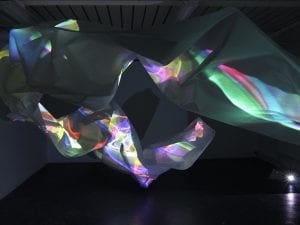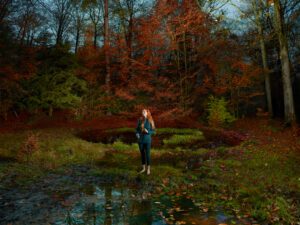Anna Fafaliou is a London-based conceptual and visual artist. Fascinated by the relationship between the colour white and memory, she creates imaginary environments that call into question the visual and physical ways of experiencing how we perceive, process and record our immediate environment. Aesthetica talk to the artist about the playfulness of abstraction and the everyday within her works.
A: Your works play around with the notions of reality and abstraction – why do you think these themes are important within contemporary society?
AF: Living in a consumer society, we tend to justify ourselves through our belongings; thus we associate our emotions and memories with materials and objects. My work focuses on the fluidity and instability of our visual perception and memory in relation to the physical presence, and how spatial relationships can be disrupted and are open to interpretation. Inspired by the notion of memory, identity and visual perception I create installations and performances exploring the relationship between object, memory and space. Since our environment is constantly changing, I’m very interested in the observation of the way we respond to these realities. Every form of creative expression is always in response to the environment we live in, to our current reality. And whether we adapt, react or even push further, it’s always in response to our environment, to our world.
A: How do you think the everyday objects and belongings that feature in a lot of your pieces discuss the emotional landscapes which people construct? i.e. the connections we make between the objects that surround us and the feelings attached to them?
AF: My practice relates to the sense of attachment that people have with the objects from their past; from old houses, family heirlooms, presents from lovers etc. Somehow these trace the story of our lives and where we come from, therefore capturing who we are. Keeping them is like keeping the memories alive,it’s almost as if we don’t have the objectified proof the memory would fade away. And we are our memories. We are a collection or better said a selection of our memories and these objects we own/we inherited reflect who we are. My research started as such. My work is based on autobiographical elements. In some of my first works like the installation performance All I Can Remember where the materials I work with were from my personal collection, from my childhood, from my grandmother’s house etc … It was a very personal project, where I wanted to emotionally explore the notion of attachment and identity.
A: Could you talk about your interest in colour theory, and particularly the colour-blocking of white which appears in a lot of your works?
AF: The white stands at the centre of all my projects. Inspired by Kandinsky’s writings on white: “White resonates, like a silence that can suddenly be understood.” The use of whiteness further refers to the neutrality and mutability beyond the materiality and individuality of the object. Whilst white isn’t stimulating to the senses, it opens the way for the creation of anything the mind can conceive. Too much white can cause feelings of isolation and emptiness. By painting the objects, I’m giving them not a new identity, but the space and time of re-writing on them. I’m not trying to make them something different – I’m just trying to see them as they would look from a time distance. How they can seem better or more pleasant from a nostalgic point of view.
A: How do you think colour is linked to memory and the perception of the world around us?
AF: We remember in colours; they trigger our emotions and our feeling of attachment.
There is a huge research in social psychology, neuroscience etc. around our relationship with colour. Different colours can have different impact in our behaviour, psychological state and memory. As they stimulate our emotions they add intensity to our memories associated with them.
A: Your installation works play around with the idea of the space that surrounds us and how it can be disrupted – could you explain how this works in terms of the artwork?
AF: Some of my works, like for example Not Formed Yet, Surface and Fold, are based on the distortion of objects creating new shapes and forms in order to question the relationship between body-space-object. With simple minimal lines and sharp cuts, I frame the movement to my sculptures giving them an abstract identity. I’m experimenting with a variety of materials including metals. My last conceptual work is materialised through the existence of mirror polished metal and perspex in various forms. These works refer to the physicality and ephemerality of the material creating a dialogue between the space, the object and the viewer. The manipulation of the object leading it to its final form shows the mutually shaping process of human identity and urban space.
A: What is your main inspiration for making these environmental responses?
AF: Observing our perception of the environment that surrounds us and how we translate what we see; the language with which we experience our environment.
A:What are your future plans in terms of projects and/or exhibitions?
AF: I was invited to re-produce my performance piece in Bangkok’s Art & Cultural Centre in September, which I’m very looking forward to do. Then I’m creating an installation for the Crossrail Garden in Canary Wharf for October organised by MTArt, and I’m also creating a project room for The Other Art Fair in London. After this I’m going to Los Angeles for a couple of months as a resident artist of Eastside International where I’m going to get involved with Otis College of Art to produce a series of lectures and workshops to further develop my research in collaboration with undergraduate students.
Credits:
1. Illusions, Perspex / silver mesh / acrylic paint / elastic cord, (2016).
2. All I Can Remember, installation-performance, collected objects / paint / cords, (2015).
3.: Erase You Erase Me, performance, (2015).







